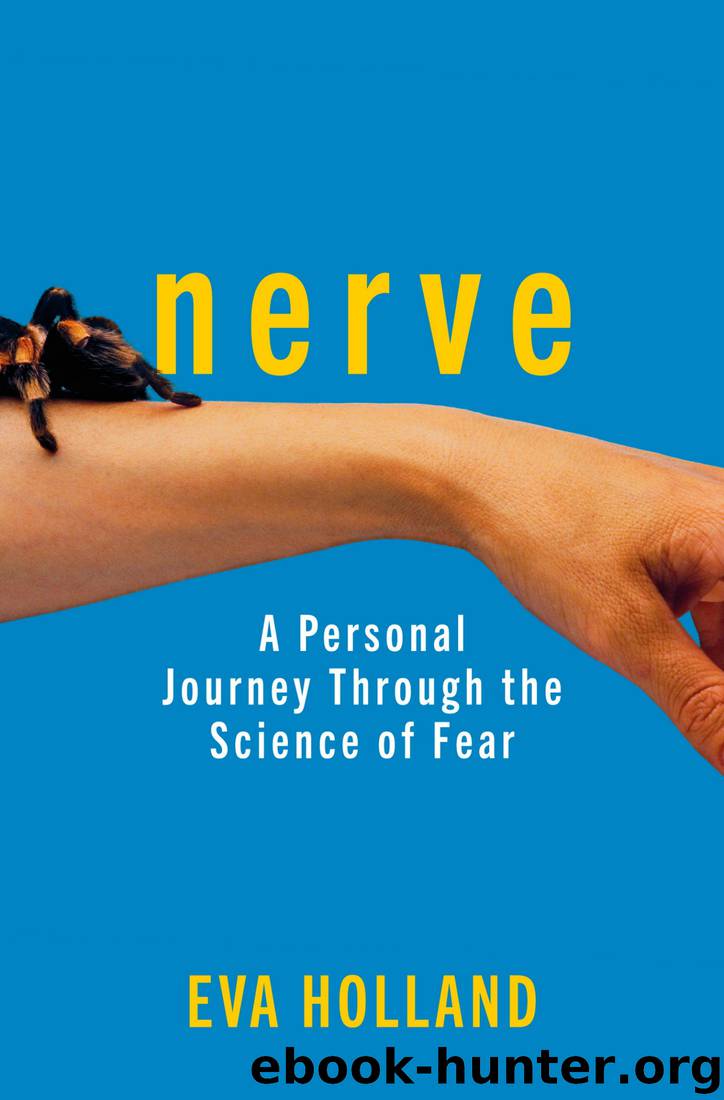Nerve: Adventures in the Science of Fear by Eva Holland

Author:Eva Holland
Language: eng
Format: epub
Publisher: The Experiment
Published: 2020-04-13T23:00:00+00:00
* * *
—
In 1872, Charles Darwin published The Expression of the Emotions in Man and Animals, a follow-up to On the Origin of Species and The Descent of Man. In it, he described the physical ways that humans display their escalating levels of fear. When they reach an “agony of terror,” he writes, “all the muscles of the body may become rigid, or may be thrown into convulsive movements. The hands are alternatively clenched and opened, often with a twitching movement. The arms may be protruded, as if to avert some dreadful danger, or may be thrown wildly over the head…In other cases there is a sudden and uncontrollable tendency to headlong flight; and so strong is this, that the boldest soldiers may be seized with a sudden panic.”
There was something familiar in that description, something that hinted at a condition still a century away from widespread clinical attention and recognition. During the muddy slaughter of the First World War, the Brits called it “shell shock.” I remember seeing the jerky black-and-white footage in a high school history class: young men twitching madly, eyes wild, apparently driven to a breakdown of control over their bodies by the relentless horror of the trenches. Initially these soldiers were eligible for treatment and pensions, but as the diagnosis spread further and further, the alarmed military brass tried to suppress the problem.
“Caught between taking the suffering of their soldiers seriously and pursuing victory over the Germans,” Bessel van der Kolk writes in The Body Keeps the Score, “the British General Staff issued General Routine Order Number 2384 in June of 1917, which stated, ‘in no circumstances whatever will the expression “shell shock” be used verbally or be recorded in any regimental or other casualty report, or any hospital or other medical document.’ All soldiers with psychiatric problems were to be given a single poker-faced diagnosis of ‘NYDN’ (Not Yet Diagnosed, Nervous).” The understatement would have been funny if it weren’t so damaging.
Medical research into how to treat the condition was discouraged or suppressed too, until a renewed outbreak, in the Second World War. And this pattern repeated itself again, in the United States at least, with the Vietnam War. When van der Kolk, then a young psychiatrist, attempted to treat Vietnam veterans struggling after their return from Southeast Asia, he was dismayed to discover that there were no resources specific to the condition available to him—no textbooks, no protocols. He writes:
In those early days at the VA, we labeled our veterans with all sorts of diagnoses—alcoholism, substance abuse, depression, mood disorder, even schizophrenia—and we tried every treatment in our textbooks. But for all our efforts it became clear that we were actually accomplishing very little. The powerful drugs we prescribed often left the men in such a fog that they could barely function. When we encouraged them to talk about the precise details of a traumatic event, we often inadvertently triggered a full-blown flashback, rather than helping them resolve the issue. Many
Download
This site does not store any files on its server. We only index and link to content provided by other sites. Please contact the content providers to delete copyright contents if any and email us, we'll remove relevant links or contents immediately.
| Anatomy | Animals |
| Bacteriology | Biochemistry |
| Bioelectricity | Bioinformatics |
| Biology | Biophysics |
| Biotechnology | Botany |
| Ecology | Genetics |
| Paleontology | Plants |
| Taxonomic Classification | Zoology |
Sapiens: A Brief History of Humankind by Yuval Noah Harari(13130)
The Tidewater Tales by John Barth(12047)
Do No Harm Stories of Life, Death and Brain Surgery by Henry Marsh(6352)
Mastermind: How to Think Like Sherlock Holmes by Maria Konnikova(6280)
The Thirst by Nesbo Jo(5822)
Why We Sleep: Unlocking the Power of Sleep and Dreams by Matthew Walker(5682)
Sapiens by Yuval Noah Harari(4584)
Life 3.0: Being Human in the Age of Artificial Intelligence by Tegmark Max(4544)
The Longevity Diet by Valter Longo(4468)
The Rules Do Not Apply by Ariel Levy(3939)
The Body: A Guide for Occupants by Bill Bryson(3863)
The Immortal Life of Henrietta Lacks by Rebecca Skloot(3845)
Why We Sleep by Matthew Walker(3802)
Animal Frequency by Melissa Alvarez(3772)
Yoga Anatomy by Kaminoff Leslie(3726)
Barron's AP Biology by Goldberg M.S. Deborah T(3646)
The Hacking of the American Mind by Robert H. Lustig(3603)
All Creatures Great and Small by James Herriot(3544)
Yoga Anatomy by Leslie Kaminoff & Amy Matthews(3423)
